Immune particle swarm optimization of linear frequency modulation in acoustic communication
2015-04-11HaipengRenandYangZhao
Haipeng Renand Yang Zhao
Shaanxi Key Laboratory of Complex System Control and Intelligent Information Processing, Xi’an University of Technology,Xi’an 710048,China
Immune particle swarm optimization of linear frequency modulation in acoustic communication
Haipeng Ren*and Yang Zhao
Shaanxi Key Laboratory of Complex System Control and Intelligent Information Processing, Xi’an University of Technology,Xi’an 710048,China
With the exploration of the ocean,underwater acoustic communication has attracted more and more attention in recent years.The underwater acoustic channel is considered to be one of the most complicated channels because it suffers from more serious multipath effect,fewer available bandwidths and quite complex noise.Since the signals experience a serious distortion after being transmitted through the underwater acoustic channel, the underwater acoustic communication experiences a high bit error rate(BER).To solve this problem,carrier waveform interdisplacement(CWID)modulation is proposed.It has been proved that CWID modulation is an effective method to decrease BER. The linear frequency modulation(LFM)carrier-waves are used in CWID modulation.The performance of the communication using CWID modulation is sensitive to the change of the frequency band of LFM carrier-waves.The immune particle swarm optimization (IPSO)is introduced to search for the optimal frequency band of the LFM carrier-waves,due to its excellent performance in solving complicated optimization problems.The multi-objective and multipeak optimization nature of the IPSO gives a suitable description of the relationship between the upper band and the lower band of the LFM carrier-waves.Simulations verify the improved performance and effectiveness of the optimization method.
underwater acoustic communication,carrier waveform inter-displacement(CWID),multi-objective optimization,immune particle swarm optimization(IPSO).
1.Introduction
The main challenge of the underwater acoustic communication systems is obtaining a higher transmission bit rate(TBR)and a lower bit error rate(BER)under the constraints of limited bandwidth,extended multipath,severe fading and rapid time variation[1].The underwater acoustic channel is recognized as one of the most complex communication channels[2].The communication scheme based on phase shift keying(PSK)modulation and time reversal mirror(TRM)equalization is a widely used underwater acoustic communication method in recent years [3–6].
M-ary phase shift keying(MPSK)modulation can be used to improve the TBR,however,the BER will increase with the increasing of the TBR due to the weaker difference between the carrier waveforms of different symbols. To solve this problem,a modulation method referred to as carrier waveform inter-displacement(CWID)modulation was proposed recently in[7].The CWID modulation method increases the difference between the carrier waveforms of different symbols,as a consequence,it obtains a higher TBR and a lower BER as compared to conventional MPSK.The frequency band of the linear frequency modulation(LFM)carrier-waves used in CWID modulationaffects the performanceof the communication. Therefore,it is important tond out the optimal frequency band of the LFM carrier-waves to take full advantage of CWID modulation.The objective of the optimization is to obtain a higher TBR and a lower BER,simultaneously, which is a typical multi-objective optimization problem, meanwhile,it is also a multi-peak optimization problem because different zones of parameters contribute to different peak performances.The previous work[8]proposed to use the genetic algorithm(GA)to solve this problem by giving a different weight to different objectives and mergingthemulti-objectiveto asingle objective.However, it is difcult to determine the optimal weights.In addition, different weights and initial population will lead to different optimized results.We cannot obtain any rule(or principle)for selecting parameters in such cases.The work in [9]gives a particle swarm optimization(PSO)algorithmto solve this problem due to its multiple objective optimization nature and Pareto optimality(PO).By the way givenin[9],wend a group of parameters and deduce a rule to select the upper band and the lower band of the LFM carrier-waves.However,this optimization problem is not only a multi-objective but also a multi-peak optimization problem.PSO is easy to get into a locally optimal solution in a multi-peak area.Immune particle swarm optimization(IPSO)is one of the improved PSOs,which introduces the immune algorithm(IA)into the original PSO [10–12].IPSO cannd a globally optimal solution with a larger probability than PSO since IA increases the diversity of the swarm.In this work,IPSO is used to solve the optimizationproblem.Using the propertyofPO in the procedure of IPSO,we observetwo peaks of the parameter set about the upper band and the lower band of the LFM frequency.A comparison is conducted in this paper to show the improvedresults of the proposedIPSO methodas compared to the previous works.
This paper is organizedas follows.Section 2 introduces the IPSO algorithm.Section 3 compares the performance of PSO and IPSO in solving the multi-objective and multipeakoptimizationproblem.Section 4 givesa briefdescription of the underwater acoustic communication system using CWID.Section 5 shows how to get the optimization results by using IPSO.Section 6 gives the comparison results of communication schemes using the optimized parametersandsomeexistingresults.Section7concludesthe work.
2.Immune PSO
PSO is an optimization method that imitates the process of birds’food searching,which has been recognized as a useful optimization method[14].PSO can operate without anypriorknowledgeofthe precisemodelofthe problemto be optimized.It is suitable for complex optimization problems.PSO is likely to get into a locally optimal solution in a multi-peak optimization problem,while IPSO cannd a globallyoptimal solutionwith a largerprobabilitysince IA increases the diversity of the swarm and helps the particle to avoid clustering around axed peak(possible local maximum).IPSO is one of the improved PSOs,which maintain the diversity of the particle by co-operating IA with PSO,and could help the particles to avoid falling into a locally optimal solution.
IA is a bionic algorithm that imitates the function of human’s immune system.Human’s immune system can decrease the amount of the antibody which has a too large density or stops immunizing with any antigen.Due to this mechanism,IA has been proved to be an effective optimization method[13].IA has advantages in solving the multi-peak optimization problem because of its aforementionedmechanismof preventingprematurity.Theow chart of IPSO is shown in Fig.1.
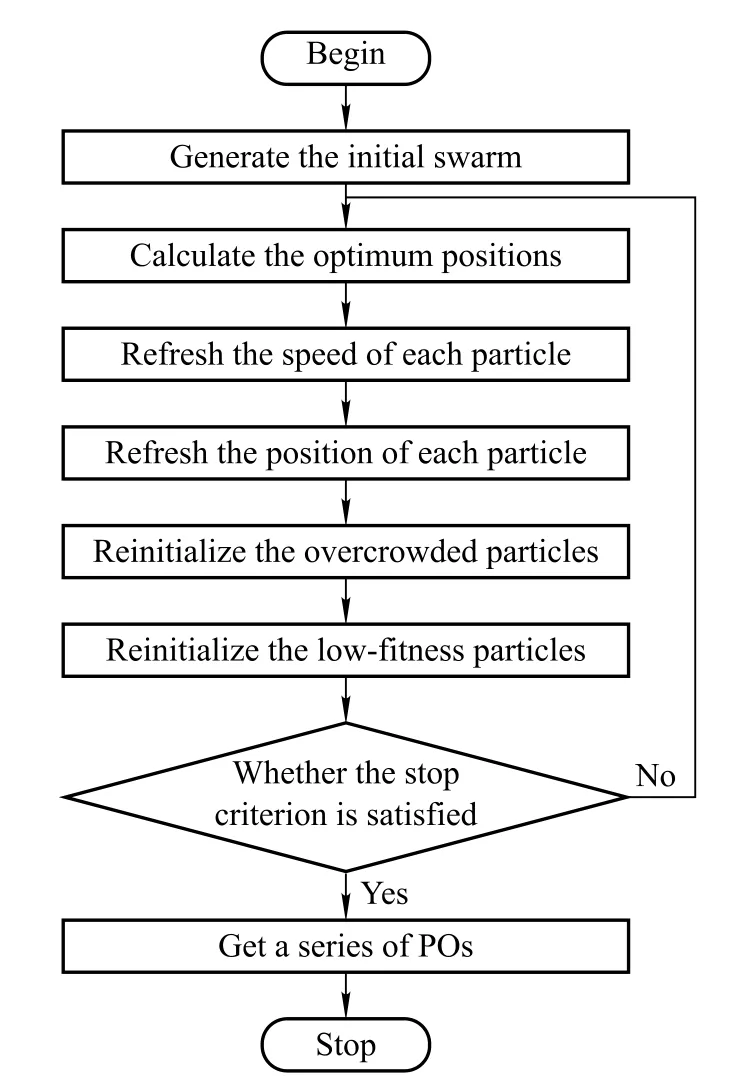
Fig.1 Flow chart of IPSO
The IPSO algorithm includes the following steps:
Step 1InitializationofIPSO.Firstly,the initial population of the swarm should be determined.Secondly,the initial speeds of the particles should be determined.Thirdly, the individual historical optimum positions of the particles should be determined.
Step 2Evaluationof the optimumpositions.The speed refreshing and the position refreshing of each particle depend on the individually optimum position and the locally optimum position of its neighbors.In order to operate the speed and the position refreshing reasonably,the individually optimum position and the locally optimum position should be evaluated.
Step 3Refreshing of the speed and the position of each particle.After getting the individually optimum position and the locally optimum position of its neighbors, refreshing of the speed is implemented according to these optimumpositions.Speedcontrolis alwaysusedtoprevent the particle from moving too fast to meet the PO position. After refreshing the speed,the position will be refreshed according to the speed.
Step 4Immune operation.Two immune operators are introduced into IPSO.Firstly,the particles,which cluster overcrowdedly,will be re-initialized randomly.Secondly,the particle with the lowesttness for either of the two optimization objectives within its neighbor will be reinitialized randomly.The aim of the immune operation isto maintain the diversity of the particle and to replace the lowtness particle with a new particle.
Step 5Stop criterion.The stop criterion is that the POs become stable.Generally,after axed number of steps of iteration,the algorithmstops,and thenal POs are derived and shown as the possible optimum parameters.
3.Comparisonperformance of IPSOand PSO for multi-objective and multi-peak optimization problem
To demonstrate that IPSO is more suitable for the multiobjective optimization problem in a multi-peak area as compared to PSO,a comparison is conducted for a standardmulti-peakproblemgivenin[15].Thestandardmultipeak function is

The standard multi-peak surface is shown in Fig.2. FromFig.2,we seethat thereareninepeaksin therangeof optimization.The objective is tond a maximum function value with two coordinatevalues both being minimum,i.e.

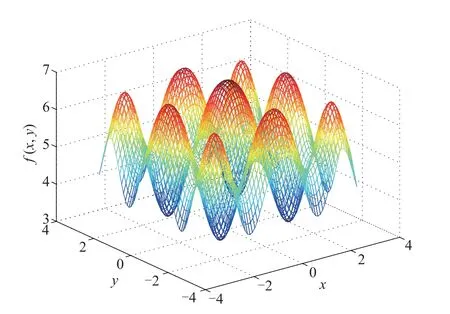
Fig.2 Standard multi-peak surface given by(1)
This is a multi-peak and multi-objective problem.The PO is dened as the particles that belong to the intersection of the(two)sets composed by the particles with thetness ranking within therst 30%corresponding to the(two)objectives,respectively.According to the denition of the PO,the POs of the optimization problems(1)and(2)locate in the marked area in Fig. 3,if we take the whole area x,y ∈ [−3,3]into account.The POs found by using PSO is shown in Fig. 4 with a particle size of 1 000.The POs found by IPSO with the same particle size are given in Fig.5. The circles in both Fig.4 and Fig.5 represent the area where the POs are located in Fig.3.
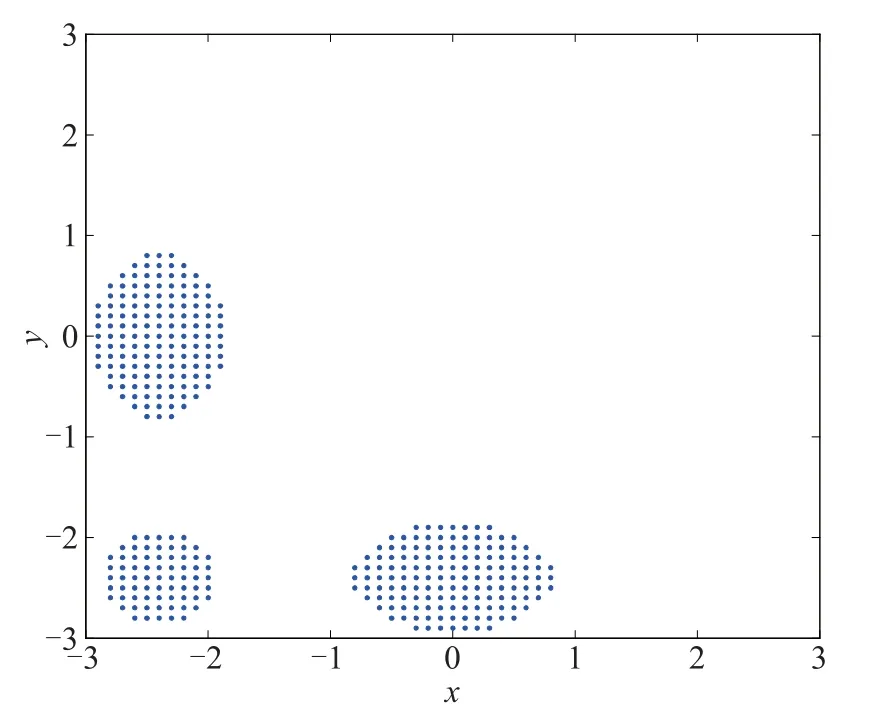
Fig.3 Areas where the POs are located
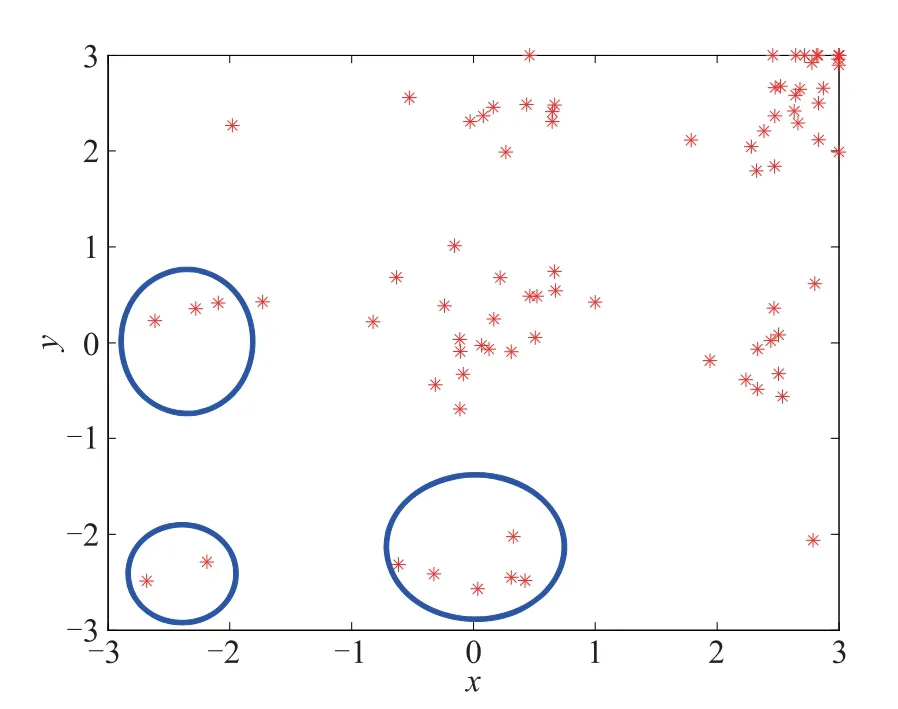
Fig.4 POs found by PSO
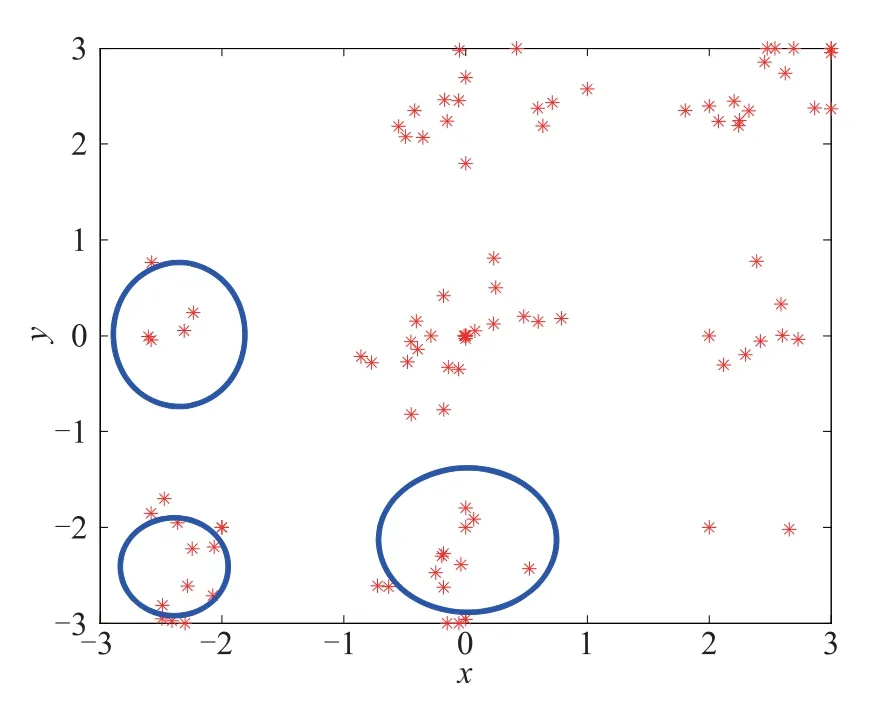
Fig.5 POs found by IPSO
According to Fig.4 and Fig.5,we can see that the number of POs located within the circle in Fig.5 is larger thanthat in Fig.4,therefore,IPSO is considered to be the better optimization method in solving the multi-objective optimization problem in the multi-peak area.
4.Acoustic communication scheme using LFM
In order to reduce power consumption,the simple underwater acoustic communication system used in this paper consists of modulation(in transmitter),equalization and demodulation(in receiver).The modulation method is CWID modulation in[7],the equalization method is passive time reversal mirror(PTRM)equalization and the demodulation method is matchedlter demodulation.
4.1CWID modulation
The PSK modulation represents different symbols using different initial phases of a sinusoidal or an LFM carrierwave[16–17].MPSK could improve TBR in communications,but,the difference between different carrier-waves becomes weaker since the separation of the initial phase between different carrier-waves is decreased.As a result, it is more difcult for the receiver to demodulate correctly. It means that the less difference between different carrierwaves leads to a higher BER.
To solve this problem,CWID modulation was proposed in[7].In the CWID modulation,a special position in the carrier waveforms,the position with the maximum amplitude of LFM signals,is selected to divide the LFM signal intofourpiecesofsub-carriersignals.Thedividingmethod is given in Fig.6.Then the sequence of the pieces of sub-carrier signals is reorganized to produce new carrierwaves.Thecarrier-wavesof4-CWID modulationusingthe pieces derived in Fig.6 are illustrated in Fig.7.
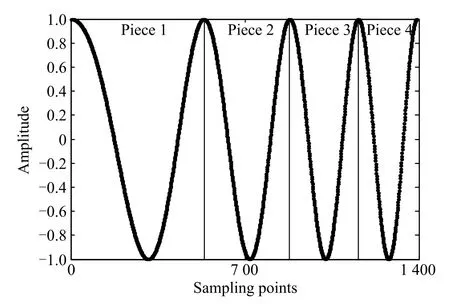
Fig.6 Dividing method for LFM carrier waveforms
From Fig.7(a),we see that code‘00’is modulated using the original sequence of the pieces,i.e.the sequence‘Piece 1’,‘Piece 2’,‘Piece 3’,and‘Piece 4’;the sequence of‘Piece 3’,‘Piece 1’,‘Piece 4’,and‘Piece 2’modulates code‘01’as shown in Fig.7(b);the sequence of‘Piece 2’,‘Piece 4’,‘Piece 1’,and‘Piece 3’modulates code‘11’as shown in Fig.7(c);the sequence of‘Piece 4’,‘Piece 3’,‘Piece 2’,and‘Piece 1’modulates code‘10’as shown in Fig.7(d).Compared with the LFM QPSK,4-CWID possesses more difference between different symbols[7].

Fig.7 4-CWID carrier waveforms
4.2PTRM equalization
PTRM,which matches the underwater acoustic channel automatically without any prior knowledge,is widely used to recover the signal from the severely distorted(received) signal caused by the underwater acoustic channel[1,3,18].
4.3Match flter demodulation
The results in[7]demonstrate that,compared to the LFM QPSK modulation,andsome otherexisting methods, the CWID modulation contributes to a lower BER and a higher TBR under the same communication situation.But the optimum frequency band of CWID is not determined. In this paper,we use the IPSO tond the optimum frequency band of the CWID.
5.LFM parameter optimization using IPSO
According to the prior knowledge,the optimization problem in this paper is a multi-objective one in the multi-peak area[8–9].The details of the LFM carrier-wavesoptimization by using the IPSO approach are given in this section.
5.1Variables to be optimized
The lower and the upper limit frequencies of the LFM carrier-waves are the two parameters to be optimized by IPSO.According to the prior knowledge,the range of the lower limit frequency is 1–16 kHz,and that of the upper limit frequency is 17–32 kHz.
5.2Initialization of IPSO
By a trial and error procedure,wend that the population of35gets an outstandingperformancein this problem.The initial speed of each particle is set as 0,since the particles do not know anything about the situation,and cannot decide where to go.The initial individually optimum position of each particle is set as its current position due to the above reason.
5.3Evaluation of the ftness
The speed refreshing and the position refreshing of each particle depend on the individually optimum position and the locally optimum position of its neighbors.Thetness evaluation procedure is given as follows:rstly,TBR of each particle is calculated,and we sequence the swarms according to the TBRs(from high to low),thenve neighbor particles in the sequence are selected to establish a neighborhood area;secondly,BER of each particle is calculated,and we select the particle with the lowest BER in each neighborhood area derived in the last step as the locally optimumparticle.The individuallyoptimumposition will refresh as the present position,when the TBR of the present particle position is higher,while the BER of the present particle position is lower than the previous particle position.The TBR and BER of each particle in the above procedure are obtained through simulating the communication in the underwater acoustic channel model proposed in[7,19].
The selection of the neighborhood area is a dynamical procedure since the sequence of the particle after ranking by TBR is different each time.The dynamical selection of the neighborhood area is to exchange the information of all swarms,which can contribute to the globally optimal result.
The neighborhood area selected in this paper is a multi-neighborhood area because the optimization problem might be a multi-peak one.The multi-neighborhood area in a multi-peak optimization case also contributes to get the globally optimal result.
5.4Refreshing of the speed and the position of each particle
The position is refreshed accordingto(3).Speed control is used in this paper.The speed is refreshed according to(4).

where xi(t)is the position of particle i at iteration t,vi(t) is the velocity of particle i at iteration t,yi(t)is the local optimum of particle i at iteration t,andis the global optimum among all particles at iteration t.
5.5Immune operation
Two immune operators are introduced in IPSO to maintain the diversity of the particle and eliminate the lowtness particles by changing them into new particles.
5.6Stop criterion
The stop criterion is that the particles are refreshedfteen times.We select this stop criterion since we believe that thetness of the swarm is nearly stable at that time.
6.Comparison results
In the optimization results,140 POs are found through 20 times simulations.The locations of the POs are shown in Fig.8.

Fig.8 PO particles found by using IPSO
In Fig.8,compared with the result in[9],we cannd that the POs found by IPSO are more detailed than that found by PSO.The POs found by IPSO are located in two main areas.Accordingto the followingsimulation,the two areas can be dened as the area with a high TBR and the area with a low BER as shown in Fig.8.Simulations were done to demonstratethe correctness of the denition of the two areas.The simulation results are shown in Fig.9 and Fig.10.The comparison between the scheme of the optimized frequency with a high TBR for 4-CWID and theother existed approaches is shown in Fig.9,which shows theperformancefunctionsofsevenmethodsversusthesignal to noise ratio.The performance in Fig.9 is dened as TBR-50000*BER.Using the parameter located in the low BER zone,the comparison is shown in Fig.10.Fig.10 shows the performance functions of seven methods versus the signal to noise ratio,where the performance is dened differently as TBR-300000*BER to emphasize the BER.

Fig.9 Comparison between high TBR 4-CWID and other methods
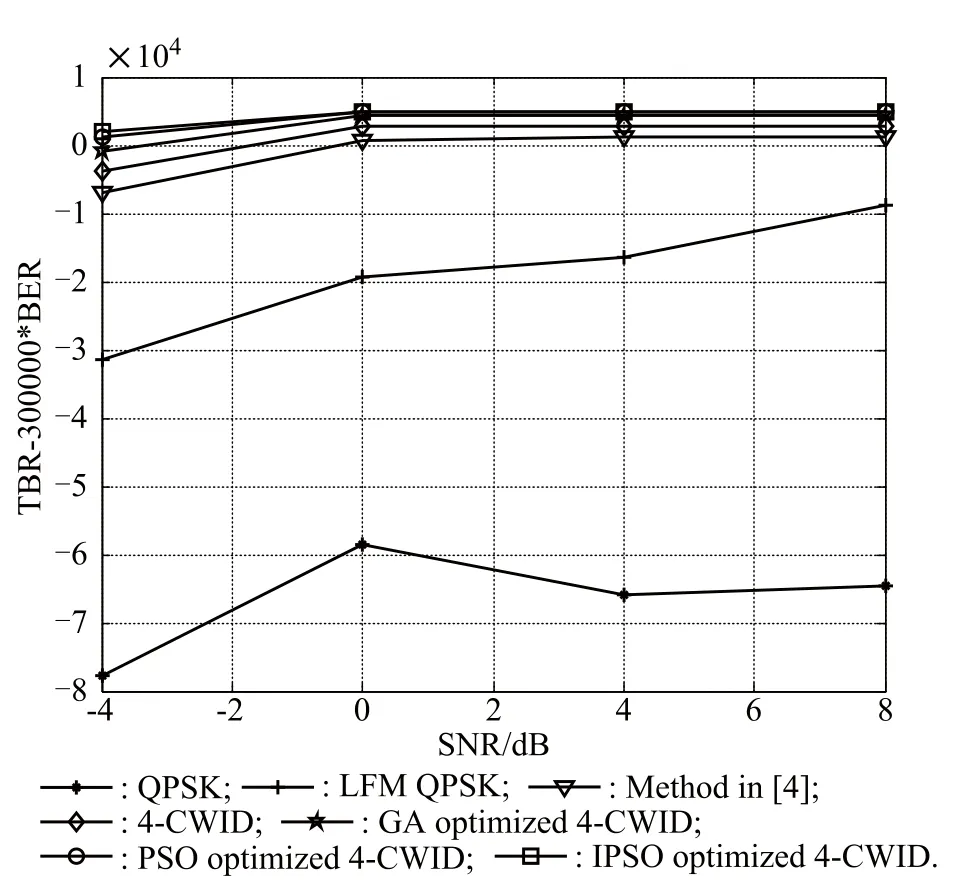
Fig.10 Comparison between low BER 4-CWID and other methods
Fig.11showstheenlargedplotofFig.10aboutthethree best performanceapproaches.Accordingto Fig.9 and Fig. 10,we cannd that the frequency band obtained in this paper has the best performance.
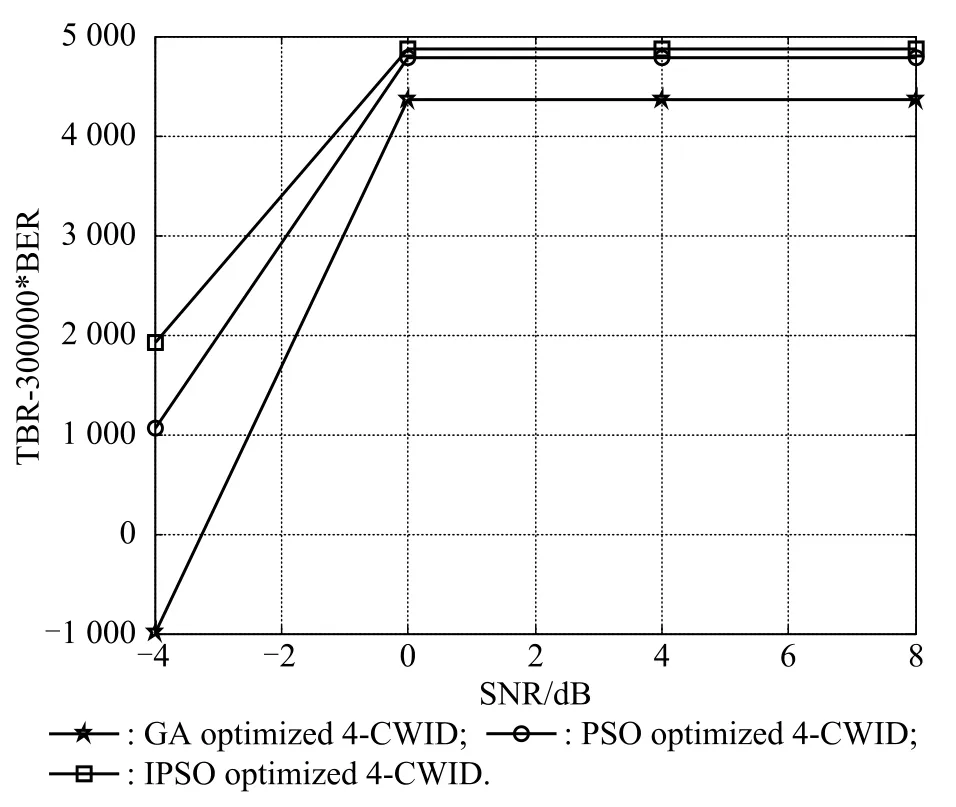
Fig.11 Enlarged plot of Fig.10 for the three best performance approaches
7.Conclusions
IPSO optimization is proposed tond the optimal frequency band of the LFM carrier-waves in CWID modulation.The simulation results obtained by IPSO can give a clear direction in choosing the frequencyband of the LFM carrier-waves in different communicationsituations.Comparison of the simulation results shows the superiority of the optimized frequency band and the effectiveness of the IPSO optimization.
[1]M.Chitre,S.Shahabudeen,M.Stojanovic.Underwater acoustic communications and networking:recent advances and future challenges.Marine Technology Society Journal,2008, 42(1):103–116.
[2]M.Stojanovic,J.Preisig.Underwater acoustic communication channels:propagation models and statistical characterization. IEEE Communications Magazine,2009,47(1):84–89.
[3]G.F.Edelmann,T.Akal,W.S.Hodgkiss,et al.An initial demonstration of underwater acoustic communication using time reversal.IEEE Journal of Oceanic Engineering,2002, 27(3):602–609.
[4]D.Rouseff,D.R.Jackson,W.L.J.Fox,et al.Underwater acoustic communication by passive-phase conjugation:theory and experimental results.IEEE Journal of Oceanic Engineering,2001,26(4):821–831.
[5]C.Keeser,B.J.Belzer,T.R.Fischer.Shallowunderwater communication with passive phase conjugation and iterative demodulation and decoding.Proc.of the 43rd Annual Conference Information Sciences and Systems,2009:907–912.
[6]G.S.Zhang,J.M.Hovem,H.F.Dong.Experimental assessment of adaptive spatial combining for underwater acoustic communications.Proc.of the 5th International Conference Sensor Technologies and Applications,2011:178–183.
[7]H.P.Ren,Y.Zhao.A novel underwater acoustic communication method based on phase shift keying carrier waveform inter-displacement.http://arxiv.org/abs/1312.7441.
[8]H.P.Ren,Y.Zhao.Optimal design of modulation parameters for underwater acoustic communication.International Journalof Information and Electronics Engineering,2014,4(2):166–170.
[9]H.P.Ren,Y.Zhao,J.Li.Determine optimal bandwidth for modulation in underwater communication channel based on PSO.Proc.of International Conference Information Science, Electronics and Electrical Engineering,2014:1990–1994.
[10]S.J.Nanda,G.Panda,B.Majhi.Development of immunized PSO algorithm and its application to hammerstein model identication.Proc.of IEEE Congress Evolutionary Computation, 2009:3080–3086.
[11]S.J.Nanda,G.Panda.Automatic clustering algorithm based on multi-objective immunized PSO to classify actions of 3D human models.Engineering Applications of Artifcial Intelligence,2013,26(5):1429–1441.
[12]L.Deng,J.Jiang,M.R.Fei.PID parameters tuning and adaptation based on immunity particle swarm optimization.Process Automation Instrumentation,2013,34(2):65–71.(in Chinese)
[13]M.Khaleghi,M.M.Farsangi,H.Nezamabadi-pour,et al. Pareto-optimal design of damping controllers using modied articial immune algorithm.IEEE Trans.on Systems,Man, and Cybernetics-Part C:Applications and Reviews,2011, 41(2):240–250.
[14]A.P.Engelbrecht.Fundamentals of computational swarm intelligence.London:Wiley,2009.
[15]S.Song,X.J.Yu.Multi-peak function optimization using a hierarchical clustering based genetic algorithm.Proc.of the 6th International Conference Intelligent Systems Design and Applications,2006:425–428.
[16]A.Goldsmith.Wireless communications.Cambridge:Cambridge University Press,2005.
[17]K.G.Kebkal,R.Bannasch.Sweep-spread carrier for underwater communication over acoustic channels with strong multipath propagation.Journal of the Acoustical Society of America,2002,112(5):2043–2052.
[19]M.Chitre.A high-frequency warm shallow water acoustic communications channel model and measurements.Journal of the Acoustical Society of America,2007,122(5):2580–2586.
Biographies

Haipeng Ren was born in 1975.He received his Ph.D.degree from Xi’an University of Technology,2003.He is now a professor in Xi’an University of Technology.His interests include nonlinear system control,complex networks and communication with nonlinear dynamics.He is an IEEE member.He serves on the editor board for two English journals.He obtained the National Invention Award(second class)of China,2013 and three science and technology awards from the government of Shaanxi province.He was awarded the Fok Ying Tong Education Foundation in 2008.He held 15 China invention patents.He has published more than 70 journal and conference papers.
E-mail:haipengren@gmail.com

Yang Zhao was born in 1988.He received his M.S. degree in control theory and application in Xi’an University of Technology in 2013.His interests are underwater acoustic communication and digital signal processing.He received the awards of national scholarship for graduate students in 2013.He has published three journal papers.He currently works as an electrical engineer for Xi’an RealEct Electronic Development Co.,LTD.
E-mail:zhaoyang.show@hotmail.com
10.1109/JSEE.2015.00052
Manuscript received May 26,2014.
*Corresponding author.
This work was supported by the National Natural Science Foundation of China(61172070,61111130122),the Innovative Research Team of Shaanxi Province(2013KCT-04),and the Specialized Research Fund for the Doctoral Program of Higher Education(20126118110008).
杂志排行
Journal of Systems Engineering and Electronics的其它文章
- Multi-channel differencing adaptive noise cancellation with multi-kernel method
- Combined algorithm of acquisition and anti-jamming based on SFT
- Modied sequential importance resamplinglter
- Parameter estimation for rigid body after micro-Doppler removal based on L-statistics in the radar analysis
- Antenna geometry strategy with prior information for direction-nding MIMO radars
- Modied Omega-K algorithm for processing helicopter-borne frequency modulated continuous waveform rotating synthetic aperture radar data
